How to grow?
Having seen such beauty at least once, everyone thinks about growing this flower, but not everyone knows how to do it. First you need to purchase planting material, and you can do this either on the Internet or in flower shops.
The best time to buy is September. The bulbs should be medium-sized, with a fairly dense skin, and brown in color. Before planting, be sure to prepare a place for tulips. It should be well lit and protected from winds and drafts. In addition, you should not plant bulbs where groundwater is close, so that the planting does not rot in the future.
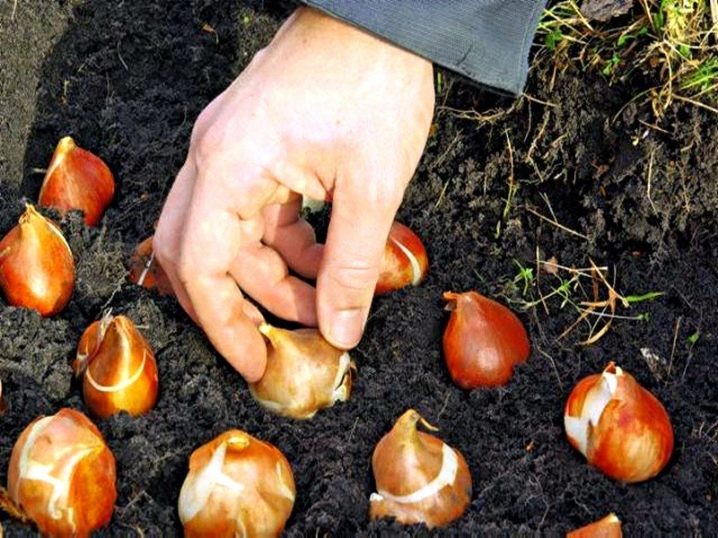
It is very important that the soil is not highly acidic. If this is the case, then you can add a little lime to this place, or take 1 glass of ash, 1 glass of superphosphate with three kilograms of peat and mix it all with the ground where future tulips will be planted
This mixture is for one square meter. In addition, this option is also considered a fertilizer. And also the earth must be well shed with a manganese solution in order to kill all the pests that are in the ground.

After preparing the soil, you can start planting the bulbs. It is necessary to maintain a distance of at least 18-19 centimeters between the rows, and up to 9 centimeters between the bulbs. The bulbs are planted at different depths. It depends on their size. For example, for large ones - the depth should be up to 14 centimeters, for small ones 6 centimeters are enough.
When the holes are made, a substrate is arranged at the bottom, it can be either sand or perlite. When all the bulbs are planted, they must be sprinkled with earth, and then mulched with either sawdust or spruce branches.

If the planting was done correctly, then until spring the tulips will not need attention. And with her arrival, it is necessary to weed, as well as remove the mulch
Over time, it is necessary to remove the weeds that have appeared, as well as apply nitrogen fertilizers. With the appearance of buds, it is necessary to feed the plants again, however, for this, phosphorus and potassium should be used.
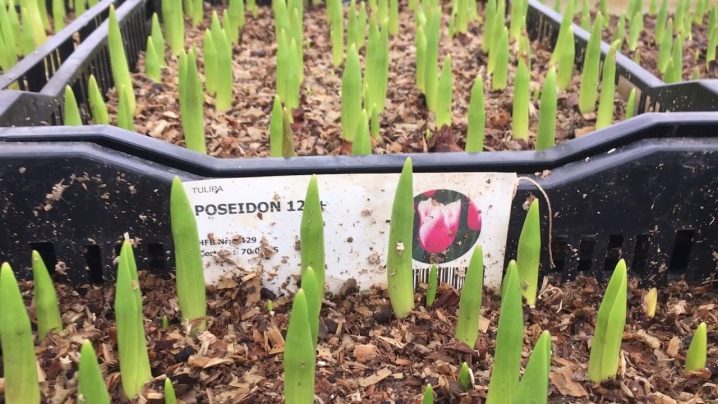
After the tulips have faded and their stem is completely dry, you need to dig up all the bulbs, as well as the babies that have formed. They must be sorted out, all dirt removed, and then put in a dry and warm place to dry out. After that, they can be planted when the time comes for this.
How to paint?
As we have already found out, tulips of a pure blue or light blue shade, the breeders have not been able to breed. However, if you really want to give the flowers unusual, unusual shades, there are several ways.
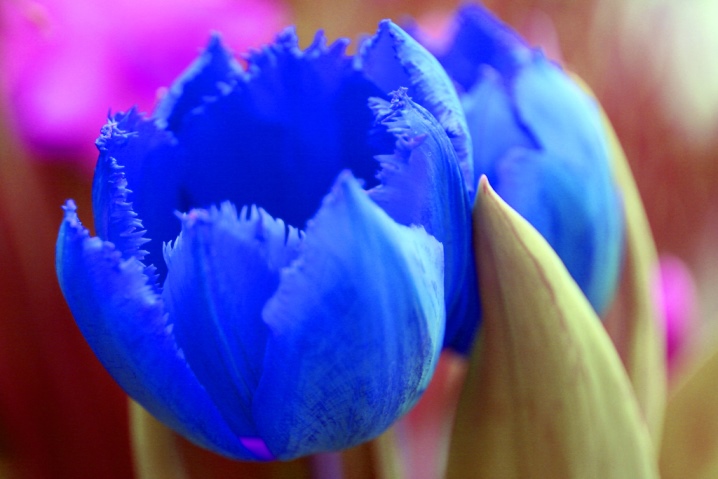
Fresh cut flowers in white or cream shades are best suited for coloring. The most common and affordable way is with food coloring. To do this, you need to purchase a dye of the desired color. Add it to a vase of water. It should be remembered that the more dye you add, the richer the color will be and vice versa.
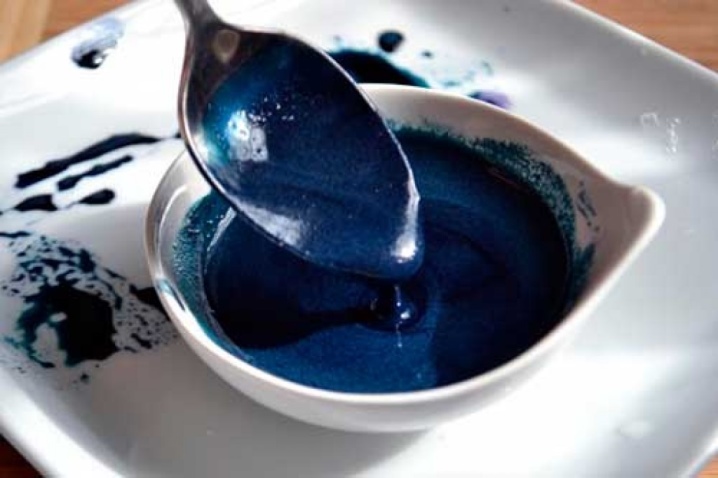
Further, excess leaves are removed from the stem of the prepared plant, and its tip is cut off with scissors at an angle of 45 degrees. Place the flowers in the water and wait. Painting can take up to 24 hours
After the petals are colored, you need to carefully remove the flowers from the solution, cut the stems again, rinse under running water and put in a vase
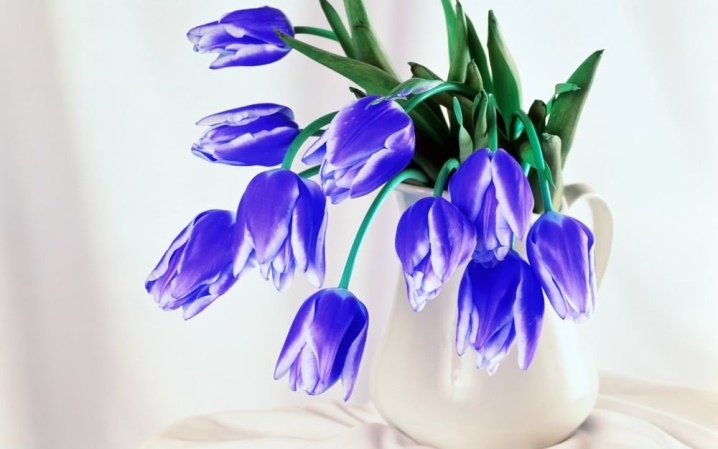
You can paint the buds of a plant in a blue tone if you water the soil around it with a solution of cobalt acid. Another method of painting involves the purchase of special floristic paint. The essence of the method is to paint the flower petals with paint on the outside, so you can use any flowers, not just white or cream ones.In order for the paint to completely color all the petals, it is necessary to select the completely blossoming flowers.
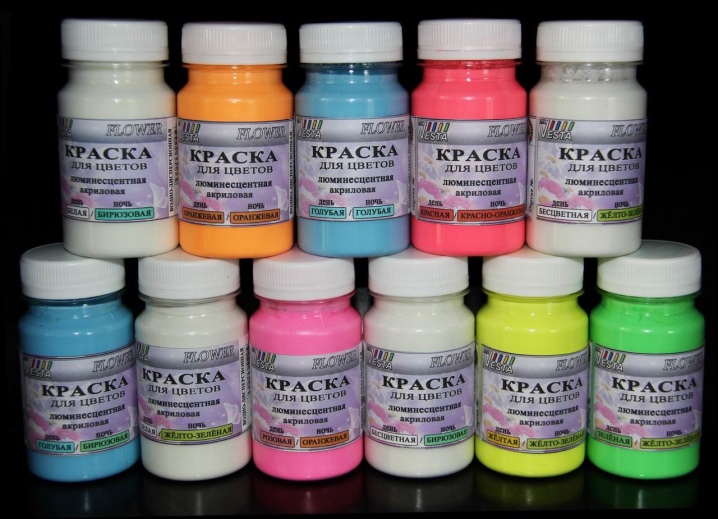
The dye is poured into any convenient container
Holding the plant by the tip of the stem, gently dip the bud into the dye and hold for a few seconds. Then take out and rinse with clean water
If paint splashes on your clothing or work surface, the stain will be difficult to remove. Place the painted flowers in a vase of water and let the buds dry completely.
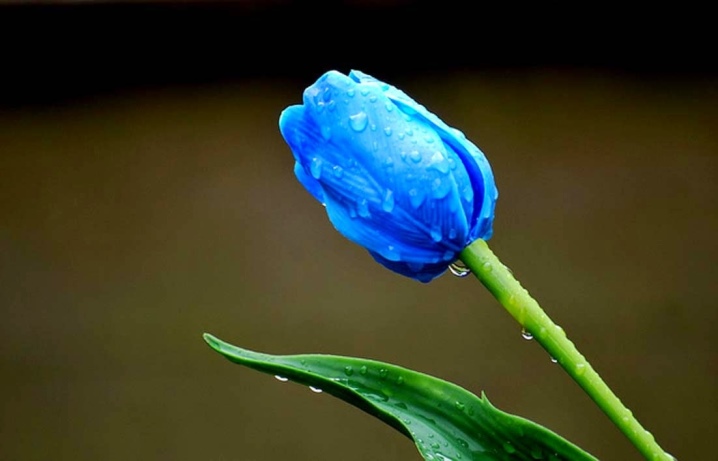
The story about blue tulips is in the next video.
Basic growing tips
Dutch tulips have won the hearts of flower growers not only because of their stunning beauty, but also due to the lack of special care requirements. However, they still require certain rules to be followed when growing. The main ones are listed below.
To plant Dutch tulips, it is necessary to find new sites every year.
Because their peculiarity lies in the fact that the bulbs will not grow in the same place.
Finding a bright spot for the flowers is equally important. Tulips of these varieties do not like cold winds and, moreover, drafts.
For tulips to grow well, the soil must be clean (weed-free).
The site needs to be prepared in a month and a half
This is a very important detail - the dug earth must have time to settle. Then this process will not damage the root system of the bulbs, and the flower will take root.
Classes of tulips of the basic classification
All known varieties and hybrids of tulips, obtained as a result of selection of several modest species of plants, multistage crosses and hybridization, are divided into 15 classes:
- Early non-double tulips
- Early double tulips.
- Tulips Triumph.
- Darwin's hybrids.
- Late non-double tulips.
- Lily-colored tulips.
- Fringed tulips.
- Green-flowered tulips.
- Rembrandt tulips.
- Parrot tulips.
- Terry late tulips.
- Kaufman tulip hybrids.
- Foster's tulip hybrids.
- Greig's tulips.
- Species, or tulips, preserving the biological characteristics of the original forms.
This classification of tulips with its 15 classes is not very convenient to use in practice. To simplify it, to facilitate the search process according to the main criterion - flowering time - varietal tulips are classified a little differently, combining them into sections depending on the main feature - flowering time, the classes are combined into four groups.
Tulip variety "Royal Maiden", medium-flowering, goblet
Absolute white is a rarity among tulips. But as close as possible to the purity of a perfectly white color, the coloring of an amazing tulip variety, the name of which perfectly illustrates the purity of its shapes and colors, came up. A classic among classics, this tulip, average in all respects (except for its showiness), conquers with its seeming simplicity.

Tulip variety "Royal Virgin". DutchGrown
The "Royal Virgin" tulip variety of the Triumph class does not amaze with its huge size or original structure, but it seems perfect and very modern. At a height of 40 to 50 cm, it surprises with the beauty of the leaves and elegance when planting in groups. The cool shade of greenery perfectly emphasizes the beauty of the bloom.
With a diameter of about 10 cm, elongated goblet, teardrop-shaped in buds, with flawless lines, these tulips seem to be perfect. Not a single wave or curvature interferes with admiring the pure shape of the flower. And the ability to grow in partial shade as well as in the sun only improves the plant's reputation.
This variety usually blooms in April, completing its parade even before the late tulips appear on the scene.
The color of the flowers of the Royal Virgin tulips cannot be called anything other than snow-white. The finest shades are not caught by the eye, and this tulip in any composition seems dazzlingly pure white.
This variety can be used for forcing and for cutting, but it is especially good in large mixed compositions.To fully reveal the beauty of the variety, it is worth planting plants in large groups. The delightful white elegance of the Royal Virgin is evident in the curbs and rocky gardens.
Features and varieties of medium-flowering tulips
All tulips that bloom at the usual time, from the end of April to May, are rightly called mid-flowering. These are varieties with large flowers, half-meter or slightly lower peduncles and bluish-green leaves. The variety of these tulips is much greater than the early ones, they are valued mainly for the size of the flowers and a variety of two-tone colors.
The mid-flowering tulips also include two classes of tulips, radically different from each other in the type of flower.
Class 3. Triumph tulips (Triumph)
This class combines medium-sized tulips with peduncles up to 50, sometimes up to 70 cm, forming goblet, very large flowers of predominantly two-tone tones. Plants have very strong stems and flowering times are easily predictable when forcing.
The obsolete, now abolished group of Mendelian tulips is almost completely included in this class, with the exception of the earliest varieties. Triumph tulips are considered one of the most sustainable.
The best varieties of medium-flowering tulips from Triumph hybrids:
- variety "Armani" - a classic goblet tulip with a large dark red flower, decorated with a blurred white border;
- variety "Barcelona" with a dark candy-pink color and a whitish-bluish bloom at the base of the outer side of the petals;
- variety "Negrita" with a delicate pink-lilac color;
- varieties "White Sail" and "Snowboarder" with a creamy white, snow-white color in the bright sun;
- variety "Charmeur" with a dark red, rich, noble color.
Medium flowering tulip from Triumph "Armani" hybrids. Mikhael GaoMedium flowering tulip from Triumph "Barcelona" hybrids. johansens-planteskoleMedium-flowering tulip from Triumph "Negrita" hybrids. gardenia
Class 4. Darwin Hybrids
Blooming in mid-spring, the goblet-shaped, large-flowered hybrid varieties have become famous for the brightest red and yellow, often two-tone colors. Darwin's hybrids, as a result of long-term selection, are able to form peduncles up to 70 cm high. The rectangular, massive bottom only emphasizes the size of the flowers. These tulip varieties are considered the most resistant.
The best varieties of Darwin hybrids:
- grade "Oxford" with a bright yellow base of a dazzling scarlet flower;
- cultivar "Apeldoorn" with a black base of a red-orange flower, decorated with a blurred yellow border;
- yellow-orange variety "Golden Springtime" - large-flowered, with a transition from peach to apricot, variety with the finest pink and red strokes;
- variety "Design Impression" with a candy pink, warm color, a slight silvery sheen of texture and delicate orange strokes in the center of the petals;
- variety "London" with wide open flowers of deep red color and with a black bottom, surrounded by a thin yellow border.
Medium flowering tulip from Darwin's Oxford hybrids. greenserviceMid-flowering tulip from Darwin's hybrids "Design Impression". fluwelA mid-flowering tulip from Darwin's London hybrids. ogorodko
Tulip cultivar "White Berliner", medium color, multicolor, or family
Any florist dreams of a legendary, albeit bred only in 1984, variety. It is not only captivatingly beautiful, but also colorful. The ability to produce not one, but more than three flowers on one peduncle turns each plant into a small bouquet. This tulip looks so elegant that it is impossible to look away from it.
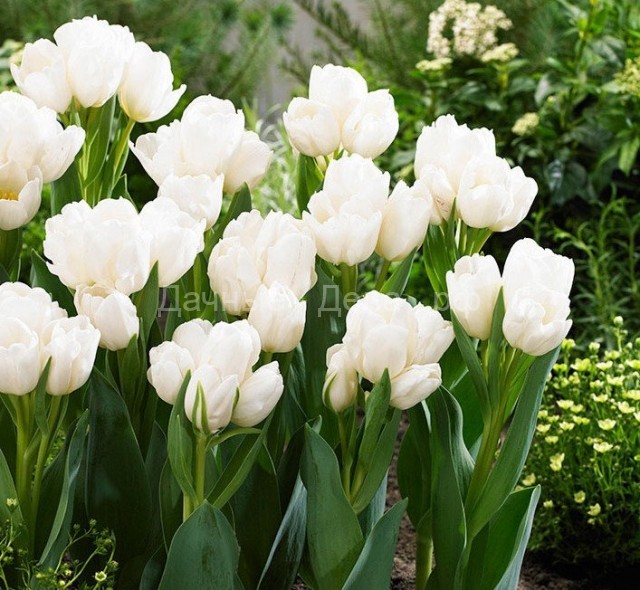
Tulip variety "White Berliner" (Weisse Berliner). Garden Seeds Market
Tulip "White Berliner" (Weisse Berliner), with a German name and Dutch selection - one of the most interesting hybrids. Medium-sized, with a strong peduncle up to 50 cm in height, it already surprises with the structure of the stems. The main, powerful shoot at the top is divided into smaller secondary ones, on which additional flowers bloom.
Elegant, almost vertical, gray castings hugging the stem emphasize the beauty of flowers tightly seated in a brush. Small and goblet, classically simple, it is due to the large number of plant flowers that seem very original.
Variety "White Berliner" - medium in terms of flowering and persistent variety, the flowers of which can be admired for several weeks.
The white color of these tulips does not appear immediately, but it looks dazzling. Creamy, warm in color buds, on which green "feathers" are clearly visible from the outside, gradually become almost snow-white, with an imperceptible yellow spot in the throat. The translucency of the petals emphasizes the beauty of the color of the plant, and the multifloral nature only enhances the effect of silk shine.
With the help of elegant "bouquets" of this variety, they decorate the foreground of flower beds and mixborders. It is indispensable for forcing or cutting, but it looks unforgettable when planted in the soil. Plants appear massive, so it is best to place them near textured lace partners.
Interesting Tulip Facts:
- The tulip is a sacred flower in many Islamic countries.
- In the early years of the spread of tulips in Europe, they were a symbol of belonging to a noble family. Lovers of these flowers included the Emperor of Austria Franz II, King of France Louis XVIII and the famous philosopher Voltaire.
- At the beginning of the 17th century, the cost of a rare tulip bulb could reach 4000 florins. During this period, tulips were a kind of money equivalent.
- In Russia, the first tulips appeared in 1702 thanks to the efforts of Peter the Great. A special department was created to supply flowers from Holland.
- In world literature, a mention of the tulip appeared in the 12th century in one of the works of Omar Khayyam, and Alexander Dumas dedicated a whole novel "Black Tulip" to the flower.
- Many residents of Holland survived thanks to the tulip bulbs they ate during World War II, when the troops of Nazi Germany took the country into a blockade.


